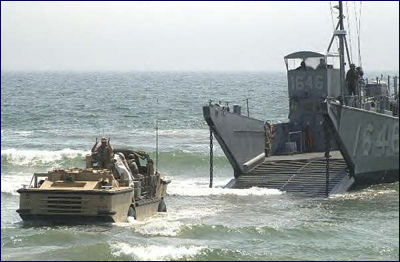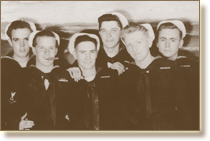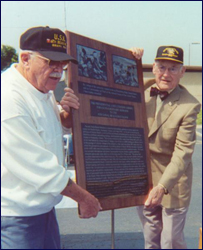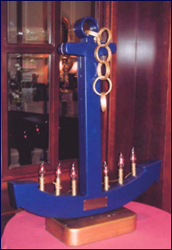030710-N-3874J-004 U.S. Naval Amphibious Base, Coronado, Calif. (Jul. 10, 2003) -- A Lighter Amphibious Re-supply
Cargo (LARC) vehicle drives into the waves, during a demonstration held for surviving veterans of D-Day. Survivors
from the 6th and 7th Naval Beach Battalions were recently invited by Beach Master Unit One (BMU-1) to watch a
demonstration of current Navy amphibious assets. D-Day Beach Battalions honored along with a demonstration, BMU-1
also presented the D-Day veterans with a plaque displaying a Presidential Unit Citation earned by them, for their
actions. U.S. Navy photo by Photographer's Mate 2nd Class Daniel A. Jones. (RELEASED)

Story Number: NNS030716-10
Release Date: 7/16/2003 12:49:00 PM
By Journalist 3rd Class Jason Trevett, Amphibious Group 3 Public AffairsSAN DIEGO (NNS)
-- Sailors of Beachmaster Unit (BMU) 1 recently spent time in the company of heroes - men who faced death to save the
world from fascism nearly 60 years ago.
A handful of World War II veterans and members of the 6th and 7th Naval Beach Battalions (NBB) who took part in D-Day
June 6, 1944, were honored at a ceremony at BMU-1's headquarters at Naval Base Coronado July 10 and 11.
The veterans, who came from throughout the country, came to see their modern day counterparts operate amphibious
landing craft and vehicles during the first day of a two-day visit to the command.
During the ceremony, a plaque displaying the 6th Naval Beach Battalion's (NBB) Presidential Unit Citation was
presented to the unit and mounted on BMU-1's quarterdeck. The ceremony also commemorated BMU-1's 54th birthday.
Retired Lt. Cmdr. Joe Vaghi, Beachmaster of 6th NBB's C-8 platoon, came from Maryland to share his experiences and
be recognized by BMU-1.
"It's amazing to be here today to tell our stories. After the war was over, I never spoke about what happened on
Omaha Beach for almost 50 years," Vaghi said. "Our unit suffered lots of casualties, and our boys showed a lot of
bravery in order to get the job done."
Moving men and equipment across the beach during the D-Day invasion was the mission of the 2nd, 6th and 7th Naval
Beach Battalions at Normandy, France. [Julius Shoulars,
Clifford Goodall, and
Beachmaster Mortimer Caplin]
They were in the first wave of Americans to land on Omaha Beach. Supporting the assault from the sea, these naval forces
were components of the Army's Engineer Special Brigades, responsible for organizing the American landings in France.
The NBBs were tasked with providing battlefield medicine, establishing communications between ship to shore,
marking sea lanes, boat repairs, removing underwater obstructions and directing the evacuation of casualties.
In June of 2001, the 6th NBB mounted a memorial plaque on the 5th Engineer Special Brigade Monument, overlooking
the beach.
"I was very impressed with the eagerness the veterans had in talking about their experiences," said Hospital Corpsman
2nd Class Jamie Shaddock, of BMU-1. "It is very inspiring."
These Sailors were depicted in the first scenes of Steven Spielberg's movie "Saving Private Ryan." The NBBs were
represented by the distinctive red-rainbow markings on their helmets during the graphic opening scenes of American
troops under fire.
"It was an honor for us as a command to pay tribute, and to have these veterans visit us and tell us their stories,"
said Lt. Cmdr. Carlos Guzman, who is BMU-1's executive officer. "I believe it builds pride and gives us a greater
appreciation for our technology and our history. They showed remarkable drive to get a job done that they knew no
one else could do."
BMU-1 Commanding Officer Cmdr. Edward J. Harrington attempted to reunite history with the present, as he remarked
about the accomplishments of the NBBs and the continuing missions of today's Naval Beach Units. "Our Delta Team
left San Diego in January for Kuwait and Iraq, and some came under fire from enemy forces," said Harrington. "They
were the first Beachmasters to arrive and the last to leave."
Although the equipment has changed greatly over the years, the job of the Beachmaster has changed little. "Even today,
with all this technology, you still have to get the same job done," said Norman Hartline, a 6th NBB signalman. "If
we would have had the vehicles and equipment that these guys are now operating with, we would have really done an
outstanding job on that beach."
During closing remarks of the 54th BMU-1 birthday celebration, Robert Watson
of 6th NBB and resident of Oceanside, Calif., professed his appreciation for the invitation from the command.
"This has been a wonderful, grand event. It is gratifying to be honored and recognized here after 56 years," said
Watson, referring to the presidential citation they received in 2000. "You have made some old Sailors mighty, mighty
proud and happy."
 |
 |
| After a period of amphibious warfare training, teenage
sailors of the 6th NBB prepare for liberty in Norfolk, VA. 1943. Standing left to right: Ed Herrick,
Bob Small, Tom Wiggin, Bob Watson, Dick Weyant and Roland Fortine during happier times. Three of their
"B" Company commanders were KIA during the initial phase of OVERLORD. Commander Eugene Carusi, wearing
the Navy cap, is standing at attention with his officers shortly before the 6 June 1944 cross-Channel
attack.
|
BEACHMASTER UNIT ONE HISTORY
During amphibious operations of World War II, the Shore Party was an integral part of a combat division and organized
around a Marine Pioneer Group or an Army Combat Engineer Group. In both services, Army and Marine, the Shore Party
formed the nucleus to which the various land and naval elements were assigned for an operation. The naval elements
included the Underwater Demolition Team, a Naval Pontoon Unit, and a Boat Pool.
It quickly became apparent that separate organizations were essential to ensure the mass movement and orderly flow of
troops, equipment and supplies, through the surf zone, onto the hostile shore, and across the assault beaches to
achieve the success of the amphibious operations. To accomplish this task, units called Beach Parties were formed
and were composed of members of the ship's crew. When the landing of the troops from their ship was complete,
the beach party returned to the ship.
In order to keep the initial landing beaches open to be used as temporary ports for bringing in supplies, a navy
shore unit, independent of any specific ship was needed. The Naval Beach Battalions (NBB)s were formed to fill
this gap. A NBB was composed of 3 companies; 3 platoons to each company. Each of these 9 platoons had four
sections: communications, medical, small boat repair, and hydrographic. Their specific duties were to handle all
ship to shore communications from the beach, mark and clear sea lanes for landing craft, perform repairs on damaged
boats, and arrange evacuation of casualties from the beach.
Each sector of an invasion beach assigned to a regimental combat team was run by a "Battalion Beach Group", composed
of an Army Engineer Special Brigade and its assigned NBB platoon. The beachmaster was the commander of the NBB, and
was in charge of everything up to the high tide line.
The beachmasters have been called the "traffic cops of the invasion," as they were the ones that directed the actual
landings of every craft, no matter how large or small.
Post-war analysis led to the Chief of Naval Operations' (CNO) decision on 19 July, 1948 to commission Navy Beach
Groups (NBG) as afloat commands. The NBG mission is to provide naval elements to the Amphibious Task Force to
support the landing of a Marine Expeditionary Force (MEF) or to the Maritime Pre-positioning Forces to offload
equipment and supplies for a Marine Air-Ground Task Force (MAGTF). A beachmaster Unit was later commissioned
for the purpose of maintaining the special teams to control boat traffic and conduct boat salvage operations
in the surf.
BMU-1 was commissioned at the U.S. Naval Amphibious Base, Coronado, California, 13 July 1949.
On 11 July 2003, as indicated, Naval Beach Battalion veterans attended Beachmaster Unit ONE's 54th Birthday
Celebration in Coronado, California. Veterans and families were honored and deeply touched when the ATB's entire
quarterdeck wall was filled with framed invasion photos and Beachmaster Joe Vaghi's 2001 speech delivered in
Normandy (written into the 20 July 2001 Congressional Record). Mounted in the center of the ATB wall is a
beautiful laser-engraved plaque with the famous 1944 photo of John Gallagher wounded on the beach and the 6th
Naval Beach Battalion Presidential Unit Citation.


Robert Watson on the left and Beachmaster Vaghi were just presented the heavy plaque. Ed Marriott said "the affair was
truly a highlight in my extended naval career." The 6th NBB memorial anchor built by Marriott's C-8 shipmate, Richard
"little boats" Strickland, has a permanent home in the BMU ONE Quarterdeck.
 Back to Top
Back to Top











